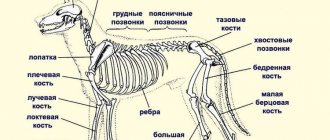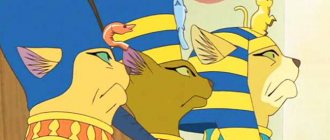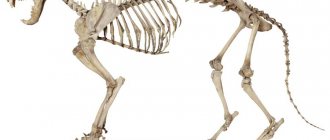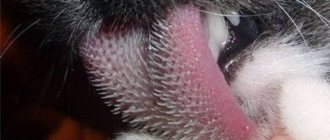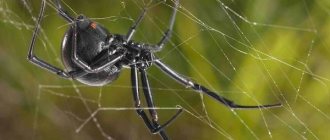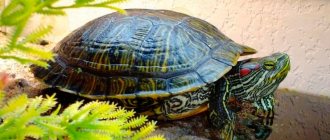Digestive system
The cat's digestive system consists of:
- esophagus;
- stomach;
- small intestine;
- duodenum;
- jejunum;
- liver;
- large intestine.
The esophagus has a hose-like shape of a relatively small size, and connects the animal’s mouth and its stomach. The esophagus originates from the inner base of the mouth, extends through the neck and chest, passes close to the heart, extends through the muscles of the diaphragm, and connects to the stomach. It is important to note that the esophagus is equipped with special muscles that push food into the stomach, producing synchronous movements similar to waves. The esophagus is one of the most difficult organs in terms of surgical treatment, as it is difficult to access and extremely difficult to heal.
The cat's stomach is single-chambered, and is distinguished by the location of the mucous membrane on its inner walls. The cat's stomach is adapted to accommodate a large amount of food, but it is almost never completely filled, since cats are not prone to gluttony (the vast majority). Also, the inner surface of the stomach is dotted with folds, which have an additional mechanical effect on the process of breaking down food. Food processed by gastric juice enters the duodenum through the pyloric sphincter. Most often, eaten food remains in the stomach for about 12 hours.
The small intestine is a tubular organ that connects the stomach and large intestine. Often the length of a cat's small intestine is about 1.5-2 meters, and includes the duodenum, jejunum, and ileum.
The duodenum is small in size and serves to mix food with liver and pancreatic enzymes, which is extremely important for digestion.
The jejunum is the longest part of the small intestine, and its internal walls are dotted with thin hairs, which, when in contact with food that comes into contact with them, penetrate into it and suck out all the useful substances. It is here that the final extraction of all useful substances from food occurs, after which it enters the ileum, and then the large intestine, where it turns into feces.
The large intestine in cats works like in all mammals: it serves to temporarily store feces, as well as remove it from the anus. Also here, the walls of the large intestine absorb moisture from the feces stored in it, in order, if necessary, to maintain the necessary water balance in the body.
The liver is the largest gland in the cat's body, and breaks down nutrients obtained from the stomach and intestines into elements necessary for the body. It is important to note that in order to fully produce the required complex of amino acids, the cat must receive 90% protein in its diet, otherwise the animal will die, because the liver will not be able to provide the body with the necessary substances from plant foods.
General diagram of the structure of the internal organs of cats
This is interesting: Why doesn't the kitten poop?
Developmental anomaly - polydactyly
There are anomalies in the development of cats' paws - seven or eight fingers are formed on each limb.
The reason for this is a gene that is inherited and manifests itself in 50% of cases. It appears in both females and males.
This is called polydactyly or hyperdactyly, i.e. anatomical difference in the direction of increasing the number of fingers (however, as in humans).
In addition, each finger ends in a claw, which means that someone may have more claws.
The maximum number of additional toes reaches 28; such cats are listed in the Guinness Book of Records.
- better stability on uneven and unstable surfaces
- faster reaction in a dangerous situation and the need for self-defense
Among the inconveniences for the owner of such an individual is more careful care of the additional claws.
Leather and wool
Hair and skin covers the entire body of the pet. Skin is necessary to protect the skeleton and all internal organs. The fur is located on the outer part of the skin.
The skin consists of the following layers:
- Outer cellular layer.
- Epidermis.
- Dermis.
Mammal skin
The epidermis is the main shield for the body. It consists mainly of keratinized cells. The dermis is made up of connective tissue that contains blood vessels, hair follicles, oil glands, nerves and sweat glands.
Covering hairs or downy hairs can grow from hair follicles. This difference is due to the fact that cats have 2 main types of fur. But in fact there are even more of them:
- Undercoat. These hairs are located closest to the top layer of the skin. The diameter along the entire length does not change; the main task of these hairs is to protect from the cold.
- Guard hairs. These hairs are considered bristly and form the middle layer of the coat. They can be recognized with sufficient magnification, since the hairs expand closer to the end.
- Protective wool. This coat protects the undercoat and midcoat from exposure to cold.
- Vibris. These are long, hard, very sensitive hairs, they are used for touch. They are located on the chin, on the cheeks, on the mustache, on the wrists of the hind legs, and mustaches are also this type of hair.
Wool structure
Anatomy of cats in pictures
For example, the cervical region is responsible for movements made by the head; in cats it has great elasticity, so the angle of rotation is almost equal to 180 degrees. Next comes the thoracic region, which consists of 12 pairs of ribs that form the chest. The movements of the hind legs depend on the lumbar region, thanks to which cats can jump. The caudal region contains the largest number of vertebrae, which make up the animal's tail.
Cat limbs also have a rather complicated structure. Many have heard stories where a cat fell from a great height, but survived by falling on its paws. During flight, these animals are capable of turning over very quickly, in order to then fall on their paws.
Scull
Cats have the smallest skulls among other pets. It contains eleven bones, and the front part consists of thirteen bones. The bones of the skull are very strong, so they reliably protect the cat’s brain from various types of damage.
Muscles
The cat's muscular system includes about five hundred muscles, thanks to which the animal has elegance and flexibility. Cat muscles have a complex structure and amazing elasticity, which allows pets to run fast and jump high. Each muscle includes two parts responsible for performing different functions: work and support. In addition, muscles have nerve connections and blood vessels. Another muscle function is to maintain the skeleton in the correct position.
Anatomy of paws
The skeleton of a cat's limb has this structure:
- ilium;
- ischium;
- pubic bone;
- hip joint;
- femur;
- knee cap;
- knee-joint;
- tibia;
- fibula;
- hock joint;
- calcaneus;
- metatarsus;
- fingers.
The joints are highly flexible. Thanks to this, cats are rarely injured even when falling from great heights. Also, their paws can move in different directions.
The lower part of the paw consists of:
- metacarpal bone;
- tendons;
- proximal phalanx;
- middle phalanx;
- external phalanx;
- claw
There are five toes on the cat's front paws. Moreover, four of them are noticeable when looking at the paws. The fifth toe is located a little higher, and to find it, you need to feel your paw in the “wrist” area. It is rudimentary. Most cats don't use it at all. But representatives of wilder breeds develop claws on it, just like on other fingers.
The structure of a cat's hind paw differs only in the number of toes. There are 4 toes on the hind legs.
In some cases, cats may have more toes than nature intended. The reason for this is a genetic mutation that does not in any way affect the quality of life and health of the cat. It is expressed only in the presence of “extra” fingers.
Cats' paws are designed in a special way and this helps the animal hide its claws and release them when necessary. Claws, if not hidden, can interfere with walking and can also cause minor injuries. Cats need them for protection from other animals, for hunting prey, for grooming, and for holding and lifting objects.
Near each of the toes, as well as in the middle of the foot, there are soft pads not covered with hair . It is on them that the cat steps when walking. They serve as shock absorbers when jumping. The pads contain nerve endings that help the animal determine the temperature and texture of the surface, as well as sense the smallest vibrations. This helps identify approaching danger or the presence of potential prey within range. The color of the pads depends on the color of the surrounding fur and the general color of the cat.
Internal organs
- breath;
- digestion;
- blood vessels;
- urinary system;
- genitals;
- lymph.
Digestion
The length of the intestines of a predatory animal is quite small - about two meters. The system is responsible for performing complex functions.
The most important part is the teeth, which crush food. The crushed and moist food then enters the stomach through the esophagus. Here it is processed, which takes three stages: grinding, entering the duodenum, absorption.
Breath
Cats pant frequently, and this is normal. A healthy cat inhales and exhales between 17 and 100 times per minute.
The lungs are the basis of the entire respiratory system. The air ends up in the nasal sinuses, cleansed of impurities, heated and humidified, and then enters the blood vessels.
It is also worth paying attention to the cat’s larynx, which is responsible for the pleasant purring.
Circulatory system
Includes the heart muscle and a network of blood vessels. A small heart does not allow a cat to run long distances. Therefore, when an animal hunts, the main factors for a successful outcome are dexterity and cunning.
urinary system
Normalizes the balance of fluid and salt in the cat's body. The main function of the system is the removal of metabolic products, that is, urine. The kidneys are very important in this work.
Reproductive system
The most important system that ensures procreation, as well as producing hormones necessary for the proper development of the body.
What is anatomy?
Anatomy is a branch of science devoted to the study of the structure of the bodies of various creatures. Anatomy helps to establish the common features inherent in a particular species of animal. This science studies the external characteristics of species, the location of internal organs relative to each other, and clarifies their significance and functions.
Anatomy includes the following areas of science:
- osteology , which studies bone structures;
- myology , which studies the structure of muscle fibers, the location of muscles and features of work;
- syndesmology , which studies the elements connecting parts of the skeleton;
- angiology , which studies blood vessels, lymphatic and circulatory systems;
- neurology , aimed at studying the functions of nodes and parts of the nervous system;
- splanchnology , systematizing knowledge about the structure of the respiratory, digestive, excretory and reproductive organs;
- endocrinology , explaining the significance of the endocrine glands;
- aesthesiology , which studies the functioning of the senses.
These scientific disciplines make it possible to trace how the formation of the most important systems occurs, as well as to establish their interrelationships. By studying the anatomy of a cat, you can find out what distinguishes it from other mammals. Anatomical knowledge allows us to understand the purpose of certain structures of the body.
This is interesting: Why don’t adult cats like to play?
Skeleton and its parts
What a cat's body consists of can be found out through anatomy - a branch of biology that studies the structure of the body. First, you should get acquainted with the frame that holds all the important organs, that is, with the skeleton.
There are about 40 more bones in the cat skeleton than in the human skeleton, amounting to 244-250 pieces. The exact number depends on the length of the tail.
Skull and teeth
The cat's skull has 24 bones. 13 of them are on the facial part, and 11 are on the cranial part. Compared to other mammals, a cat's head is quite small in relation to its body, but it has a well-developed brain inside its skull.
The strong jaws of mustachioed pets have 30 sharp teeth. A smaller number (26) is typical only for kittens. By 7-8 months, their milk teeth are replaced by molars, and the dentition is replenished with missing molars.
Spine and tail
A cat's flexibility is due to the amazing mobility of its vertebrae. They can all be divided into 5 departments:
- cervical, consisting of the most massive bones;
- thoracic, to which 8 pairs of ribs are attached;
- lumbar, surrounded by muscles that hold the contents of the abdominal cavity;
- sacral, consisting of 3 fused vertebrae;
- caudal, including from 12 to 28 vertebrae.
Thanks to the massiveness of the cervical vertebrae, the animal can easily turn its head almost 180°, and thanks to its underdeveloped collarbones, it can easily penetrate the narrowest crevices.
The tail plays a special role. With its help, the cat maintains balance while jumping or falling from a height.
Four paws, and there are scratches on them
A cat's paw bones are not directly attached to the skeleton. They are held in place by muscles and tendons.
The hind limbs differ from the front limbs in being longer and having fewer fingers. There are as many of them in front as there are in humans, and in the back there are only 4.
Each of the fingers is equipped with a sharp claw. In a calm state, the claws are retracted into a special pouch, but when you press on the pad, they can be returned back. This is very convenient when trimming overgrown claws.
Due to the unusual location of the knee (right under the belly), cats always walk on tiptoe. This bizarre method of transportation is not only silent, but also very safe. When jumping, the paws absorb all the energy expended, so landing from a great height is soft and quiet.
Cat's fingers: structural features and functions
Representatives of the cat family normally have 18 toes on their paws, while other mammals boast limbs with twenty toes. However, thanks to this, our furry pets gain that special grace that is inherent only to cats.
Cats are special animals down to their toes.
Since cats are predatory animals, their paws are equipped with “cold weapons.” Despite the menacing appearance of the claws, these keratinized processes are very sensitive due to the presence of capillaries and nerve endings inside. Therefore, pets need to trim their nails with great care so as not to cause pain or damage to their fingers.
There are sharp retractable claws not only on the visible part of the limbs, but also where not every fan of purrs would think to look - on the lateral toes of the front paws, which are distinguished by their high and far apart location. Zoologists explain this structure by the need to climb tree trunks and other vertical objects.
Anatomically, cat toes are a combination of metacarpal bones, tendons, proximal and middle phalanges, as well as the outer phalanx and claw.
The structure of cat fingers is characterized by mobility and flexibility of joints.
Each front paw has five toes, four of which are directly involved in the cat’s movement, and the fifth is a rudiment. The hind legs already include four toes on each limb, and instead of the fifth there is a small tubercle on the surface of the feet.
The peculiarity of cats is that the fingers play the main role in moving the animal, because purrs do not step on the entire paw, but walk “on tiptoes.” In order to reduce the load on the toes, cats' feet acquired hard elastic pads during evolution - a large one in the middle of each paw and small ones next to each toe.
A cat's toes are a tool for transmitting information and a shock absorber at the same time
Cats are distinguished by the fact that they can walk almost silently. The silent movement of furry purrs has already become the talk of the town and is considered possible due to their soft paws. However, it is the fingers that are decisive here. When the flexor phalanges contract and sharply straighten, cats make jumps over significant distances, regardless of the plane on which the animal is located at the moment of movement.
In addition, the toes on the paws of representatives of the cat family perform the following functions:
- Maintaining balance and tactile sensitivity. In other words, it is the toes on the animal’s paws that help to detect even minor vibrations from the movement of mice and other rodents. The other side of the coin is the susceptibility to damage to the skin of the toe pads, which can cause the pet’s health to deteriorate significantly.
- Maintaining sustainability. Due to the fact that each toe on a cat's paw moves independently of the others, the purr can freely climb up and down trees. Moreover, the furry pet does such tricks even on vertical surfaces with an angle of 90 degrees.
The unique structure of the fingers allows cats to climb vertical surfaces
- Cushioning during jumps from high heights. Elastic pads on the fingers muffle the impact of the ground and save animals from injury to their limbs.
- Maintaining cleanliness. The desire of cats to wash themselves is evident as early as 4 months of age, and the procedure itself has become the subject of popular superstition. So, if a cat simply licks its paws, then this promises a change in the weather, and if it sits on the threshold at the same time, it means waiting for guests. In fact, the desire to keep themselves clean is due to the nature of cats, because these predators must remain invisible while hunting. In addition, due to frequent licking of the paws, the skin on the pads becomes moisturized, becoming soft and elastic.
- Transferring information about the animal to other representatives of the cat fauna. After all, on a cat’s fingers and between them there are special glands that secrete a specific smell. When a cat scratches a fence post or a tree trunk with its claws, the pet thus communicates to other purrs about its claim to a certain territory and, as a result, to the females living there.
By scratching objects, cats mark their territory.
Circulatory system
The circulatory system includes blood vessels and the heart, which transport blood throughout the body:
- Arteries are vessels through which oxygenated blood flows from the heart muscle to the organs.
- Vienna. Through them, blood saturated with carbon monoxide travels from the organs to the heart.
- Capillaries. Small vessels that allow you to establish metabolism between blood and tissues.
In cats, the heart weighs approximately 16-32 g and has 4 chambers. The right side of the heart is responsible for the venous blood supply, and the left for the arterial one. On average, a cat's heart contracts at a rate of 130-140 beats per minute. If you want to count your pet's pulse, it is better to look for the artery, which is located on the inside of the hind thigh.
circulatory system
Circulatory system
The circulatory system in cats works the same way as in other mammals: the heart pushes blood through arteries that have elastic walls and rhythmically carry out contraction and relaxation movements. It is thanks to such movements that arteries located close to the skin can be felt, and this is called the pulse. The cat's pulse is easiest to detect on the inside of the thigh, and in a healthy animal it should range between 100-150 beats per minute.
The cat's brain absorbs 15-20% of the blood, the muscular system absorbs up to 40% of the total blood, and about 25-30% of the blood goes to the internal organs. During physical activity, muscles can absorb up to 90% of the blood, which is why cats get tired so quickly, but can focus maximum strength for a short period of time.
Brain and endocrine system
The brain can be briefly described as a gray-pink nervous tissue that has 3 main parts:
- Head brain.
- Brain stem.
- Cerebellum.
Divisions of the brain
The whisker brain is made up of a billion neuron cells that are connected to another 10,000 other neurons.
The endocrine system is responsible for the release of special hormonal secretions. Thus, the endocrine system normalizes the functioning of all organs; it consists of:
- pituitary gland;
- hypothalamus;
- liver;
- kidneys;
- pancreas;
- adrenal glands;
- ovaries and testes;
- liver;
- parathyroid glands;
- part of the gastrointestinal tract.
Endocrine system
urinary system
When studying the structure of a cat, internal organs and their functions, it is worth noting the urinary system. It consists of the following organs:
- kidneys;
- ureters;
- bladder;
- urethra.
The kidneys are a paired organ located on the right and left in the lumbar region. They perform the following functions:
- regulate blood volume and extracellular fluid;
- control ionic balance in the body;
- stabilize the acid level in the blood;
- participate in blood clotting and blood pressure regulation;
- remove excess metabolic products from the body;
- regulate metabolism.
First, primary urine is formed, which contains glucose, vitamins and amino acids. It then passes through the convoluted canals and accumulates in the renal pelvis. From this point on, urine is considered secondary. It enters the ureters and bladder. As a result, urine comes out through the urethra. Spontaneous leakage is facilitated by a muscular organ - the sphincter.
Important! In healthy animals, urine has virtually no color. If it turns orange or brown, this may indicate urolithiasis.
In cats, the urethra is wider and shorter than in cats. Because of this feature, females are less likely to experience urinary problems.
Sense organs
The sense organs are represented by a group of important components, which include: vision, smell, taste, hearing. The correct functioning of this system ensures the health of the cat, as well as survival in different conditions.
Visual
Cat eyes are the largest of all pets. Developed vision allows the animal to see not only small details and prey, but also navigate in the dark. The cornea protrudes forward, so the viewing angle is 250°.
Interesting! Experts have found that cats are able to distinguish up to 6 colors.
Auditory
Cats' hearing allows them to detect sound with a frequency of up to 65 kHz. The ear canal consists of 3 parts:
- Outer ear. This part is located on the pet’s head. With its help, sounds are captured and collected, and then transmitted to the eardrum.
- The middle ear transmits the signal from the membrane to the inner ear.
- The inner ear converts sound vibrations into nerve impulses.
Taste buds
Felines are able to distinguish almost all tastes, except sweet. Special papillae located on the tongue help recognize food. Each papilla contains about 30,000 taste buds.
Smell and touch
The sense of touch is accomplished through the whiskers. They are located in front of the pet's face. Animals are able to perceive 2 times more odors than humans. The main organ of smell is the nose. However, there is an additional organ on the upper palate - Jacobson's organ.
Interesting! A cat's nose has a unique imprint comparable to a human finger.
Respiratory system
The task of the respiratory organs is to ensure gas exchange and deliver oxygen to the tissues. The process of releasing excess moisture also goes through them. The respiratory system participates in heat exchange and removes excess heat and harmful gases.
Respiratory organs of a cat:
- nose;
- nasopharynx;
- bronchi;
- trachea;
- lungs.
Bengals and other breeds weigh up to 6 kg, the Maine Coon can weigh up to 13 kg
The nasal cavity is surrounded by mucous membrane, which performs the function of smell. Thanks to the villi on the epithelium, the nose serves as a filter that cleans the incoming air from dust and dirt. The larynx has vocal cords that allow the animal to meow.
A cat's lungs are made up of many alveoli. The left lung is slightly larger in volume than the right (8 and 11 cm3, respectively).
Internal and external genitalia of a cat
The reproductive system of a female cat consists of the following organs:
- ovaries;
- the fallopian tubes;
- uterus;
- vagina;
- vestibule of the vagina;
- external genitalia.
The cat has bleeding on the second day after giving birth
The ovaries are a paired organ located in the lumbar region. This organ is responsible for the formation of hormones and the maturation of germ cells. Pets regularly ovulate, which allows them to become pregnant.
Important! If the owner does not plan to breed cats, then it is advisable to sterilize the cat. Otherwise, hormonal imbalances, tumor development, cystitis and other diseases are possible.
The fertilization process takes place in the fallopian tubes, after which the egg passes into the uterus. The uterus is a hollow organ that consists of a cervix, body and horns. The vagina is an organ that connects the cervix and the external genitalia. At the onset of puberty, the cat's ovaries increase in size.
The structure of the reproductive system of cats
The vulva serves as the external organ of the reproductive system in cats. It is located below the anus.
Reproductive system of cats
Bad breath from a cat: causes of the disease and what can be done
The internal structure of a cat and a tom differ in the reproductive system. The cat's genitals provide the formation and transfer of seminal fluid, which includes sperm.
Diagram of the male reproductive system:
- prostate;
- vas deferens;
- scrotum;
- penis;
- testes.
The testes produce sperm and produce testosterone. Sperm is produced throughout the cat's life, or until castration.
What shapes an animal's appearance
Having figured out what the cat’s skeleton and its internal organs are made of, you can consider the external features and sensory organs. Unlike dogs, the appearance of these cats is practically no different from their wild counterparts. Exceptions include only decorative species obtained artificially.
Strong muscles
A cat's body has 517 muscles, which is 133 less than a human's. Despite this, the muscular system is very elastic. That is why mustachioed pets easily curl up into a ball and take other bizarre poses, surprising their owners with their flexibility.
Cat muscles are divided into 2 types:
- striated
, regulating the mobility of body parts and controlled by the central part of the nervous system;
- smooth
, controlling the functioning of the gastrointestinal tract, respiratory system and all internal organs with the help of impulses received from the peripheral nervous system.
Each muscle consists of 3 sections. The first ones are responsible for jumping over long distances, the second ones for running short distances, and the third ones for soft and quiet sneaking up during the hunt.
Beautiful skin
The skin covers the entire body of the animal, protecting it from temperature changes, germs and injuries. It consists of 2 layers:
- epidermis
, formed as a result of cell death and keratinization;
- dermis
containing capillaries, sebaceous glands and hair follicles.
The constant desire to rub against a person and surrounding objects is explained by the release of a specific secretion with which the cat marks its territory. It is formed from the sebaceous glands on the face, between the fingers and in the anus area.
The coat consists of undercoat and guard hairs. Each hair is capable of reflecting light, giving the coat a beautiful shine. That is why the appearance of dullness is a symptom of internal pathologies.
Thanks to the erector muscle, the hairs of a mustachioed pet can stand on end. The characteristic stripe on the back and fluffy tail can be seen in moments of fright or extreme cold.
Whiskers, paws and tail like cat documents
Differences can be seen not only in animals of different sexes, but also in animals of different breeds. The British cat's body parts are not similar to the Siamese's body parts. In the first case, the pet will be more massive and densely built, and in the second, thin and graceful.
Belonging to a particular breed is determined by the shape of the ears, the shape of the eyes, the length of the tails and paws, as well as the color of the coat and even its presence. Only short-haired breeds are divided into 3 large groups: American, European and Oriental. But there are also long-haired and bald ones.
There is even a separate classification based on body type. Thanks to such diversity, you can easily choose a pet based on your preferences and capabilities.
Structure of a cat's paw
In its structure, a cat's paw has bones:
- ileum;
- ischial;
- pubic;
- femoral;
- tibia;
- tibia;
- heel;
- metacarpal;
And:
- kneecap;
- hock joint;
- hip joint;
- metatarsus;
- fingers.
The lower limb has:
- tendons;
- proximal phalanx;
- middle phalanx;
- external phalanx;
- claw.
Skeleton of a cat's paw
The speed of movement of the animal, its silent gait, the ability to overcome obstacles, and rapidly climb an inclined plane is possible due to the special structure of the limbs.
The joints of cats are designed in such a way that when walking they turn in different directions. This helps the animal maintain balance. The flexibility of the joints helps, when falling, to turn around in such a way as to land on all limbs at once. The flexibility of the joints protects the murka from injury when jumping from great heights.
The front paws have 5 toes, one of which is located higher and does not reach the ground. The hind ones have four toes - the thumb is missing. There are pads on your pet's paw that help distribute weight evenly over the entire foot. Cats move on their fingers. This method of movement increases speed, lengthens strides and does not produce noise.
Tendons and ligaments facilitate the process of releasing and retracting the claws.
The hook-shaped claw is retracted into a pad, thus protected from environmental influences. When walking, the claws do not grind down, but if necessary, the cat puts them out and they serve as protection.
At the moment of an attack, the cat turns over on its back and puts forward its sharp claws, which can cause serious injuries to the enemy.
With their help, the predator hunts by biting into its prey. Under natural conditions, the animal constantly sharpens its claws on tree trunks. At home, to sharpen claws, it is recommended to install a scratching post, otherwise, if it is not available, the pet will sharpen its claws on the furniture.
This is interesting: How many types of cats are there in the world?
Cardiovascular system and heart
The cardiovascular system is one of the main ones in the animal’s body. It is responsible for vital processes, transports blood throughout the body and saturates tissues with oxygen.
Circulatory system
The anatomical structure of the blood of cats differs from other animals. It cannot be supplemented or replaced. Red blood cells, which are part of the blood, provide the body's organs with oxygen. As blood passes through the body, it travels through the right ventricle and into the pulmonary artery. Oxygenated blood returns to the left side of the atrium and then to the ventricle. In total, cats have 2 circles of blood circulation.
Interesting! The weight of the heart depends on the weight of the pet and usually accounts for 0.6% of the total figure.
Nervous system
The nervous system of cats is divided into central and peripheral. Each of these systems in a cat performs functions that are standard for most mammals.
The central nervous system consists of the brain, brain stem and the so-called spinal cord. The central nervous system is the most important in the body of any living creature, and simple and complex reactions, as well as some reflexes, depend on it. In addition, the central nervous system interacts with the peripheral and autonomic ones, ensuring their functioning and control.
The peripheral nervous system is responsible for the cat's conscious motor abilities. So, thanks to this system, a cat can move its paws, extend its claws, run, and generally lead the lifestyle that it leads. Also, the peripheral nervous system transmits pain impulses to the central nervous system from any part of the body where peripheral nerve endings are present.
